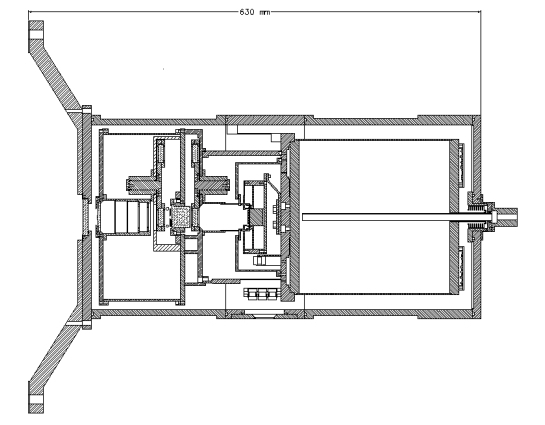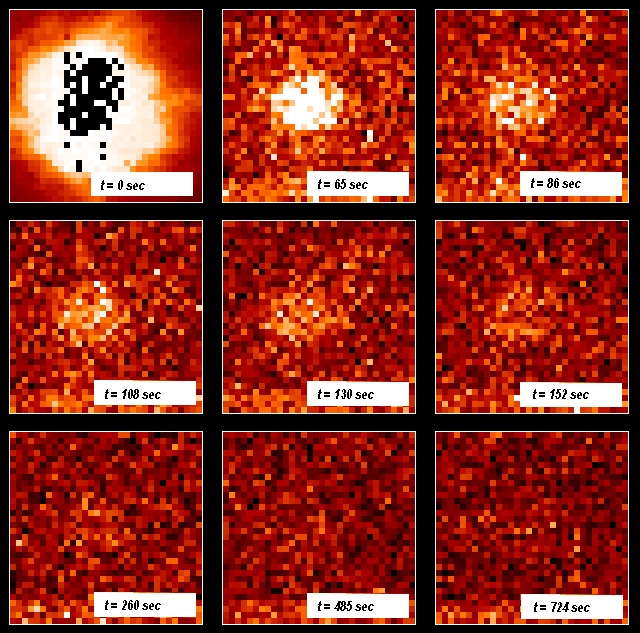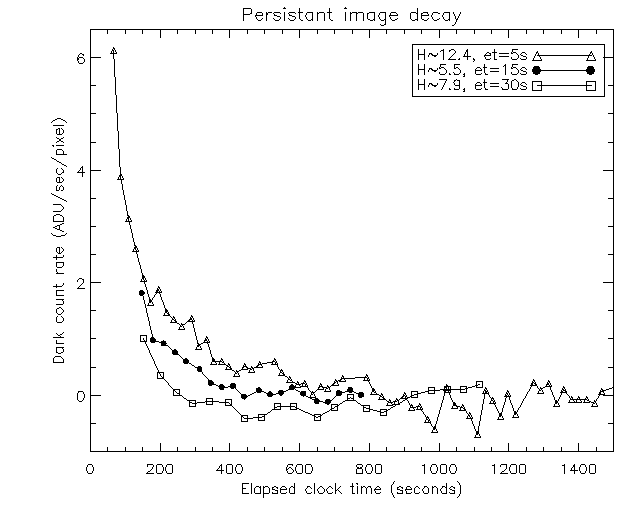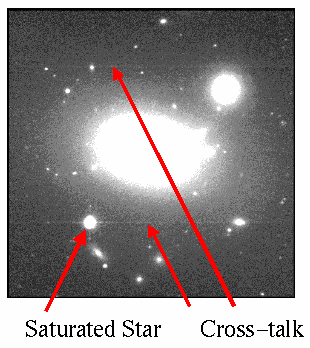
 |
QUIRC Introduction |

QUIRC is a near-infrared imager on loan from the University of Hawaii and mounted at the exit focus of Hokupa'a. It has simple 1:1 reimaging optics with a pupil mask wheel, two cold filter wheels, and a 1024x1024 HgCdTe array sensitive to 1-2.5Ám. When coupled with Hokupa'a, QUIRC has a fixed plate scale of 19.98 milliarcseconds. This gives a sampling across a diffraction-limited image of 2.9 pixels at K (2.2Ám), 2.2 pixels at H (1.6Ám), and is undersampled (1.7 pixels) at J (1.25Ám). In practice this plate scale well samples the delivered PSF. QUIRC is cooled by liquid N2.
| Filter# | Filter | Wavelength (Ám) | Bandpass (Ám) | Approx. Sky Count Rate (ADU/s/pixel) |
|---|---|---|---|---|
| 01 | J | 1.25 | 0.171 Ám | 2 |
| 02 | H | 1.65 | 0.296 Ám | 20 |
| 03 | K | 2.2 | 0.336 Ám | 60 |
| 04 | K' | 2.12 | 0.41 Ám | 60 |
| 05 | H+K notch | 1.8 | ~0.7 Ám | TBD |
| 06 | methane low | 1.56 | 120 ┼ | 1a |
| 07 | methane high | 1.71 | 120 ┼ | 1a |
| 08 | [Fe II] | 1.65 | 170 ┼ | 1a |
| 09 | [He I] | 2.06 | 30 ┼ (?) | TBD |
| 10 | 1-0 S(1) H2 | 2.12 | 23 ┼ | <1 |
| 11 | H Br(gamma) | 2.166 | ~150 ┼ | 3a |
| 12 | K-continuum | 2.26 | 60 ┼ | 1a |
| 13 | CO | 2.29 | 20 ┼ | TBD |
| 14 | J+CO | - | - | Dark position |
Notes to table:
(a) Estimated by scaling appropriate broadband sky flux by the ratio of
the bandpasses.
In addition, there is a 'neutral density' filter wheel in front of the QUIRC entrance
window. This wheel resides on the Hokupaa bench and contains four grayish filters
which can be used to lower the photon flux in QUIRC. Note that the strengths of the
filter is wavelength dependent and their values have not been calibrated on the sky.
If you plan to use any ND filter other than the default (no filter) and photometry is
important, then you must specify a photometric calibration field with the ND filter.
| Filter# | J | H | K |
|---|---|---|---|
| ND1(Default) | Clear | Clear | Clear |
| ND2 | x3.2 | x3.0 | x2.5 |
| ND3 | x17.6 | x8.8 | x6.1 |
| ND4 | x12.0 | x7.1 | x5.3 |
| ND5 | x24.6 | x11.1 | x7.3 |
Saturated pixels are common in Hokupaa/QUIRC images (e.g. a bright AOWFS source may be in the QUIRC field). The saturated pixels produce lingering high dark current. This effect decays slowly with time. Below is a series of images showing a saturated star image (t=0sec) followed by observations of the sky at various times after the last saturated image. Note that the saturated star image is the last in a sequence of many observations. The scale in the sky frames is -10 (black) to 50 (white). Sky has been removed in all frames.

As a result of this latency, false images can appear when you combine images from a dither sequence. The residual images appear as 'images' offset from the saturated source by the dither amount.
Latent images seem to persist for timescales of ~10-20 minutes. The following plot illustrates the strength of the latent image in sky frames after observing a bright star. For three different stars, the following sequence was followed: (1) observe bright star saturating the central pixels, (2) offset to sky and observe sequence of sky frames. The figure below shows the average counts above the sky in the sky frames for pixels which were heavily saturated by the star. The three stars observed differ in brightness, individual integration times, total observation time, and saturation level. However, no clear trend is established between any of these and the decay time of the persistent images. For example, the observation with the greatest photon counts per image is star 2 while the faintest is star 1. All images are in the H-band.

Saturated pixels also cause a slight shift in the bias along rows containing the saturated pixels and along corresponding rows in each of the four quadrants. This is illustrated in the bottom figure at the right. The saturated star is in the lower left quadrant and the increased bias is seen as streaks across rows of pixels. The effects is very nonlinear but typically the bias in these rows is a few percent larger than normal.

Changing exposure times produces temporarily unstable dark current. This manifests itself as changing levels near the borders of the four quadrants. It is generally best to avoid changing exposure times. You may also need to discard the first exposure after changing exposure times.
Home the filter wheel at least once a night. There are no encoders on the filter wheels so there is no positive acknowledgement of which filter position you are in. Homing the filter wheel takes some time (several minutes) but solves filter wheel ambiguities. As a guideline the approximate sky count rates for the available filters are listed in the filter table.
The filters are not confocal so the focus of QUIRC must be changed between some filters. This is accomplished by issuing a filter command to the QUIRC software and a focus move to the Hokupa'a focus stage. Note that the focal positions of each filter have been calibrated so you will not need to find the focus (Hokupa'a will do that for you!). You only need to issue the command to move the filter and the command to move the focus stage to it's calibrated position.
Scripting and interface with telescope systems: This camera is a stand-alone device and has no interfaces with the telescope control systems. The camera's software does have a minimal scripting capability, although, automation of a sequence of telescope moves and observations is not possible. As the QUIRC software is not aware of the TCS, header information is very minimal. We have implemented a external tcl/Tk program (qMon) that updates the FITS headers of QUIRC images with telescope information. Hokupa'a header information is currently not updated in the FITS header.
A number of simple quick look IRAF scripts are available for use with Hokupaa and
QUIRC. These handle simple sky subtractions and minimal header inclusions.
Last update 11 Feb 2001; Mark Chun